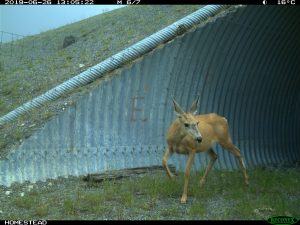If you drive for work, or even drive to and from work, familiarize yourself with measures that can help prevent collisions with wildlife.

A deer emerging from an underpass after safely crossing
the highway. Photo credit: TranBC, used with permission
Hitting wildlife with a vehicle can be very hazardous for people as well as animals. On average, each year in B.C. 4 people die and 870 are injured in collisions with wildlife. Wildlife collisions also result in financial costs related to vehicle repairs, lost productivity, and highway cleanup.
Thousands of animals are killed in these types of collisions. The B.C. Ministry of Transportation and Infrastructure (TranBC) reports that 75 percent of wildlife collisions are with deer; 15 percent are with bear, elk, and moose, and the remaining 10 percent are with a variety of other wildlife species.
Recently in Trail, for example, an elk died after being hit by a pickup truck. The driver was uninjured. The vehicle had at least $10,000 worth of damages. (Read the news story: Heads up for wildlife warn police after crash with elk on West Kootenay highway.)
Preventing wildlife collisions
Here are a few tips on how to avoid wildlife collisions from the SafetyDriven article Myth Busters — Wildlife collisions don’t just happen! Recommendations include:
- Look for posted signs warning of wildlife in the area.
- Slow down and drive to conditions. A reduction in speed as little as 5 kph could make a world of difference.
- Avoid distractions. Focus on the art of driving. A momentary lapse in concentration may be the difference between seeing an animal and taking appropriate steps to avoid contact or being surprised and colliding with it.
In its efforts to improve wildlife safety and mitigation on highways, TranBC has implemented over 500 km of wildlife exclusion fencing, safe crossing structures like overpasses and underpasses, and approximately 1,200 species-specific wildlife warning signs, the most comprehensive inventory of wildlife warning signs in the world. It has also implemented wildlife detection systems — an innovative new approach that uses radar and thermal imaging to activate LED signs when animals are close to the road.
Making a difference
It seems that the wildlife overpasses and underpasses are working. Biologists at TranBC monitored the number of deer using these wildlife crossings to cross the Okanagan Connector (Highway 97C). From January to October 2019, mule deer used the crossings more than 3,700 times. “It means the potential for 3,700 collisions with vehicles was eliminated. These mule deer were not hurt, killed, or orphaned — they crossed the highway safely thanks to the crossings made for them,” says Dr. Leonard Sielecki, manager of the TranBC Wildlife Program. You can watch the number of crossings add up in a short video, and read more from Dr. Sielecki, in It’s Amazing to See Wildlife Crossings Like Never Before.
Find more tips in the Road Safety at Work webinar Preventing collisions with wildlife. The webinar presents information such as where and when wildlife collisions take place, and strategies and processes employers can implement to reduce the risk of such collisions.
Thanks to everyone for looking out for the animals. No one likes to see an animal be hurt or killed — nor to deal with the injuries to people and the damage to vehicles.


